Vector Algebra Class 12 Maths Important Questions Chapter 10
Vector Algebra Class 12 Important Questions with Solutions Previous Year Questions
Question 1.
Find the position vector of a point which divides the join of points with position vectors
Answer:
Let given position vectors are
Let
∴
= 4
Question 2.
If
Answer:
Given vectors are
Now,
= 6î – 3ĵ + 2k̂
and
=
∴ The unit vector parallelto the vector
Question 3.
The two vectors ĵ + k̂ and 3î – ĵ + 4k̂ represent the two sides
Answer:
Given, 

Alternate Method:
Given 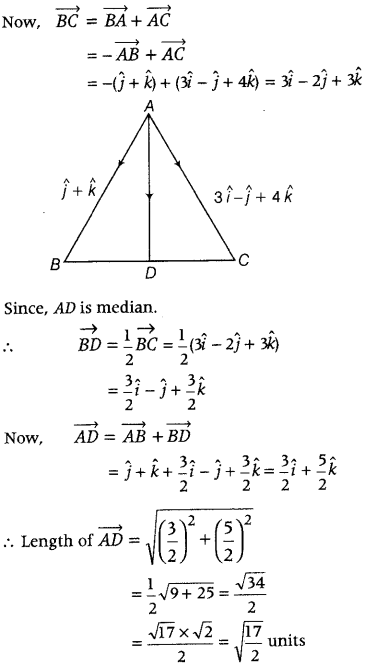
Question 4.
Write the direction ratios of the vector 3
Answer:
Clearly, 3
= (3î + 3ĵ – 6k̂) + (4î – 8ĵ + 10k̂)
= 7î – 5ĵ + 4k̂
Hence, direction ratios of vectors 3
Question 5.
Find the unit vector in the direction of the sum of the vectors 2î + 3ĵ – k̂ and 4î – 3ĵ + 2k̂. (Foreign 2015)
Answer:
Let
Now, sum of two vectors,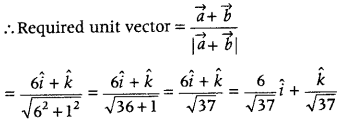
Question 6.
Find a vector in the direction of vector 2î – 3ĵ + 6k̂ which has magnitude 21 units. (Foreign 2014)
Answer:
To find a vector in the direction of given vector, first of all we find unit vector in the direction of given vector and then multiply it with given magnitude.
Let
Then, |
=
The unit vector in the direction of the given vector 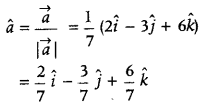
Now, the vector of magnitude equal to 21 units
and in the direction of a is given by
21â = 21
Question 7.
Find a vector a of magnitude 5√2, making an angle of
Answer:
Here, we have l = cos
⇒ l = 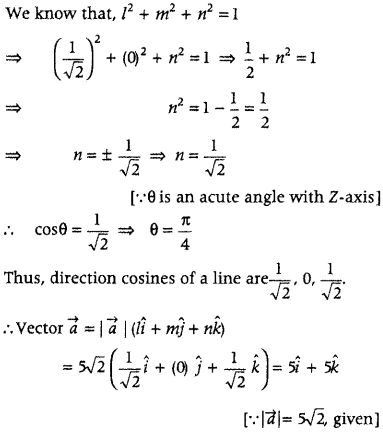
Question 8.
Write a unit vector in the direction of the sum of the vectors
Answer:
Question 9.
Find the value of p for which the vectors 3î + 2ĵ + 9k̂ and î – 2pĵ + 3k̂ are parallel. (All India 2014)
Answer:
Given, 3î + 2ĵ + 9k̂ and î – 2pĵ + 3k̂ are two parallel vectors, so their direction ratios will be proportional.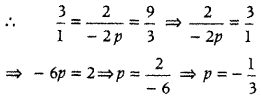
Question 10.
Write the value of cosine of the angle which the vector
Answer:
Given,
Now, unit vector in the direction of 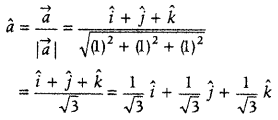
∴ Cosine of the angle which given vector makes with Z-axis is
Question 11.
Find the angle between X-axis and the vector î + ĵ + k̂. (All India 2014C)
Answer:
Let
Now, unit vector in the direction of 
So, angle between X-axis and the vector
î + ĵ + k̂ is cos α =
[∵ â = lî + mĵ + nk̂ and cos α = l ⇒ α = cos-1l]
Question 12.
Write a vector in the direction of the vector î – 2ĵ + 2k̂ that has magnitude 9 units. (Delhi 2014C)
Answer:
3î – 6ĵ + 6k̂
Question 13.
Write a unit vector in the direction of vector
Answer:
First, find the vector
Given points are P (1, 3, 0) and Q (4, 5, 6).
Here, x1 = 1, y1 = 3, z1 = 0
and x2 = 4, y2 = 5, z2 = 6
So, vector PQ = (x2 – x1)k̂ + (y2 – y1)ĵ + (z2 – z1)k̂
= (4 – 1)î + (5 – 3)ĵ + (6 – 0)k̂
= 3î + 2ĵ + 6k̂
∴ Magnitude of given vector
Hence, the unit vector in the direction of 
Question 14.
If a unit vector
Answer:
Here, we have
l = cos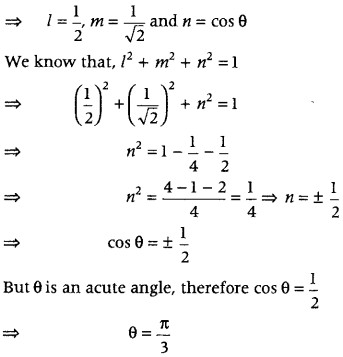
Question 15.
Write a unit vector in the direction of the sum of vectors
Answer:
Question 16.
If
Answer:
Two vectors are equal, if coefficients of their components are equal.
Given,
On comparing the coefficient of components, we get
x = 3, y = -2, z = -1
Now, x + y + z = 3 – 2 – 1 = 0
Question 17.
P and Q are two points with position vectors 3
Answer:
Question 18.
L and M are two points with position vectors 2
Answer:
5
Question 19.
A and B are two points with position vectors 2
Answer:
Given, A and B are two points with position vectors 2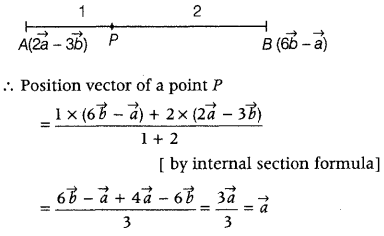
Question 20.
Find the sum of the vectors
Answer:
Given vectors are
Sum of the vectors
= – 4ĵ – k̂
Question 21.
Find the sum of the following vectors.
Answer:
3î – ĵ – 2k̂
Question 22.
Find the sum of the following vectors.
Answer:
5î – 5ĵ + 3k̂
Question 23.
Find the scalar components of
Answer:
Given initial point is A (2,1) and terminal point is B (- 5, 7), then scalar component of
x2 – x1 = – 5 – 2 = – 7and y2 – y1 = 7 – 1 = 6.
Question 24.
For what values of
Answer:
If
Let given vectors are
We know that, vectors
∴ 2î – 3ĵ + 4k̂ = k(aî + 6ĵ – 8k̂)
On comparing the coefficients of î and ĵ, we get
2 = ka and -3 = 6k ⇒ k = –
∴ 2 = –
Question 25.
Write the direction cosines of vector -2î + ĵ – 5k̂. (Delhi 2011)
Answer:
Direction cosines of the vector aî + bĵ + ck̂ are
Question 26.
Write the position vector of mid-point of the vector joining points P(2, 3, 4) and Q (4, 1, – 2). (Foreign 2011)
Answer:
Mid-point of the position vectors
Given points are P(2, 3, 4) and Q(4,1,-2) whose position vectors are
Now, position vector of mid-point of vector joining points P(2, 3, 4) and Q(4, 1, – 2) is
Question 27.
Write a unit vector in the direction of vector
Answer:
We know that, unit vector in the direction of â is â =
Required unit vector in the direction of vector
Question 28.
Find the magnitude of the vector
Answer:
Magnitude of a vector r = xî + yĵ + zk̂ is |
Given vector is a = 3i – 2/ + 6fc.
∴ Magnitude of
=
Question 29.
Find a unit vector in the direction of vector
Answer:
Question 30.
If A, B and C are the vertices of a ΔABC, then what is the value of
Answer:
Let ΔABC be the given triangle.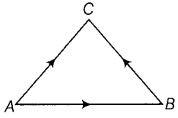
Now, by triangle law of vector addition,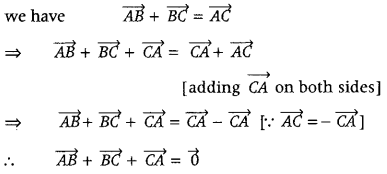
Question 31.
Find a unit vector in the direction of
Answer:
Question 32.
Find a vector in the direction of
Answer:
4î – 2ĵ + 4k̂
Question 33.
Find the position vector of mid-point of the line segment AB, where A is point (3, 4, -2) and Bis point (1, 2, 4). (Delhi 2010)
Answer:
2î + 3ĵ + k̂
Question 34.
Write a vector of magnitude 9 units in the direction of vector -2î + ĵ + 2k̂. (All India 2010)
Answer:
-6î + 3ĵ + 6k̂
Question 35.
Write a vector of magnitude 15 units in the direction of vector î – 2ĵ + 2k̂. (Delhi 2010)
Answer:
5î – 10ĵ + 10k̂
Question 36.
What is the cosine of angle which the vector √2î + ĵ + k̂ makes with Y-axis? (Delhi 2010)
Answer:
Question 37.
Find a vector of magnitude 5 units and parallel to the resultant of
Answer:
First, find resultant of the vectors a and o, which is
Given,
Now, resultant of above vectors =
= (2î + 3ĵ – k̂) + (î – 2ĵ + k̂) = 3î + ĵ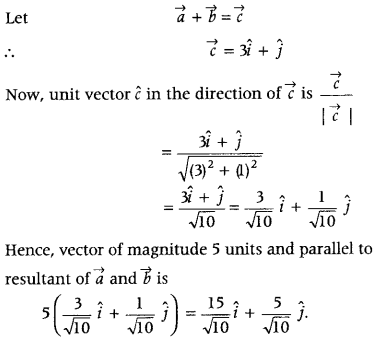
Question 38.
Let
Answer:
First, find the vector 2 a – b + 3c, then find a unit vector in the direction of 2a-b + 3c.
After this, the unit vector is multiplying by 6.
Given,
∴
= 2 (î + ĵ + k̂) – (4î – 2ĵ + 3k̂) + 3 (î – 2ĵ + k̂)
= 2î + 2ĵ + 2k̂ – 4î + 2ĵ – 3k̂ + 3î – 6ĵ + 3k̂
⇒
Now, a unit vector in the direction of vector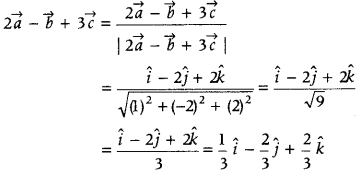
Hence, vector of magnitude 6 units parallel to the Vector
= 2î – 4ĵ + 4k̂
Question 39.
Find the position vector of a point R, which divides the line joining two points P and Q whose position vectors are 2
Answer:
Given,
and
Let OR be the position vector of point R, which divides PQ in the ratio 1 : 2 externally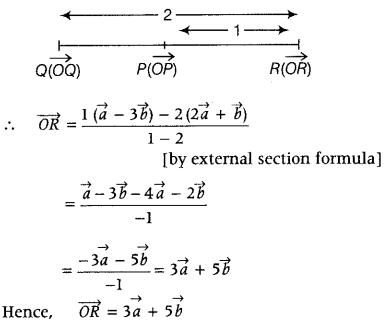
Now, we have to show that P is the mid-point of RQ,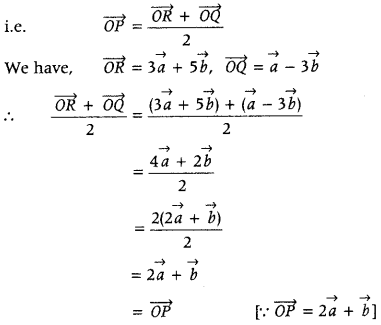
Hence, P is the mid-point of line segment RQ.
Product of Two Vectors and Scalar Triple Product
Question 1.
Find the magnitude of each of the two vectors
Answer: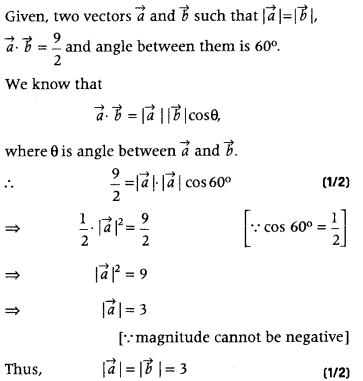
Question 2.
Find the value of [î, k̂, ĵ], (CBSE 2018C)
Answer:
[î, k̂, ĵ] = î ∙ (k̂× ĵ)
= -[[î, k̂, ĵ] = –
Question 3.
Find λ and μ, if (î + 3ĵ + 9k̂) × (3î – λĵ + μk̂) = 0. (All India 2016)
Answer:
Given, (î + 3ĵ + 9k̂) × (3î – λĵ + μk̂)
= î(3μ + 9λ) ĵ k̂
On comparing the coefficients of î, ĵ and k̂ , we get
3μ + 9λ = 0, – μ + 27 = 0 and – λ – 9 = 0
⇒ μ = 27 and – λ = 9
⇒ μ = 27 and λ = – 9
Also, the values of μ and λ satisfy the equation
3μ + 9λ = 0.
Hence, μ = 27 and λ = – 9.
Question 4.
Write the number of vectors of unit length perpendicular to both the vectors
Answer:
We know that, unit vectors perpendicular to
and
So, there arc two unit vectors perpendicular to the given vectors.
Question 5.
If
Answer: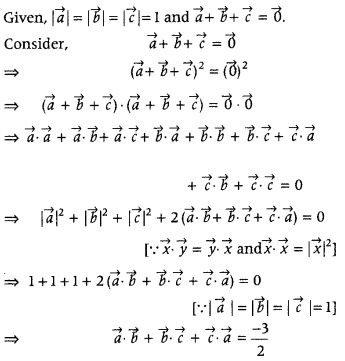
Question 6.
If
Answer: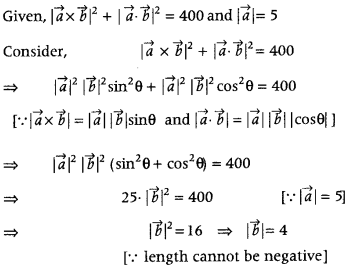
Question 7.
Find λ, if the vectors
Answer: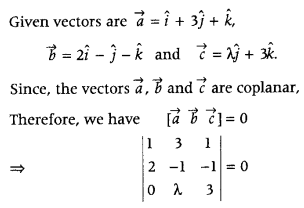
⇒ 1(- 3 + λ) – 3(6) + 1(2λ) = 0
[expanding along R1]
⇒ – 3 + λ – 18 + 2λ = 0
⇒ 3λ = 21
∴ λ = 7
Question 8.
If
Answer: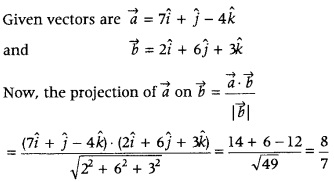
Question 9.
If â, b̂ and ĉ are mutually perpendicular unit vectors, then find the value of |2â + b̂ + ĉ |. (All India 2015)
Answer:
Given â, b̂ and ĉ are mutually perpendicular unit vectors, i.e.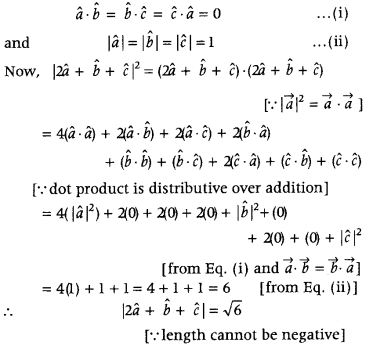
Question 10.
Write a unit vector perpendicular to both the vectors
Answer:
First, determine perpendicular vectors of
Given vector are
As we know the, vectors
Then,
= î(0 -1) – ĵ(0 – 1) + k̂(1 – 1)
= – î + ĵ
Then , the unit vector perpendicular to both 
Question 11.
Find the area of a parallelogram whose adjacent sides are represented by the vectors 2 î – 3 k̂ and 4 ĵ + 2 k̂. (Foreign 2015)
Answer:
Let adjacent sides of a parallelogram bc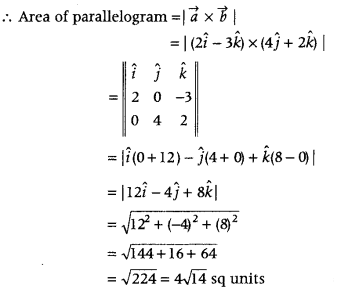
Question 12.
If
Answer: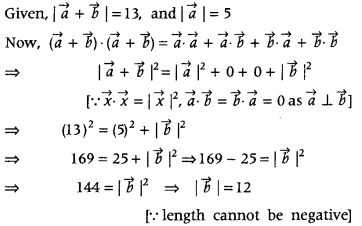
Question 13.
If
Answer:
Question 14.
Find the projection of the vector î + 3ĵ + 7k̂ on the vector 2î – 3 ĵ + 6k̂. (Delhi 2014)
Answer:
let
Question 15.
Write the projection of vector î + ĵ + k̂ along the vector ĵ. (Foreign 2014)
Answer:
1
Question 16.
Write the value of the following. î × (ĵ + k̂) + ĵ × (k̂ + î) + k̂ × (î + ĵ). (Foreign 2014)
Answer:
we have, î × (ĵ + k̂) + ĵ × (k̂ + î) + k̂ × (î + ĵ)
= î × ĵ + î × k̂ × ĵ × k̂ + ĵ × î + k̂ × î + k̂ × ĵ
[∵ cross product is distributive over addition]
= k̂ – ĵ + î – k̂ + ĵ – î =
[∵ î × ĵ = k̂, î × k̂ = – ĵ, ĵ × k̂ = î, ĵ × î = – k̂, k̂ × î = ĵ, k̂ × ĵ = – î ]
Question 17.
If vectors
Answer: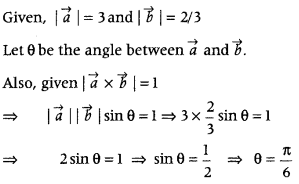
Question 18.
Find
Answer:
Given, 
= 2(4 – 1) – 1 (- 2 – 3) + 3( – 1 – 6)
= 2 × 3 – 1 × (-5) + 3 × (- 7)
= 6 + 5 – 21 = 11 – 21 = – 10
Question 19.
If
Answer: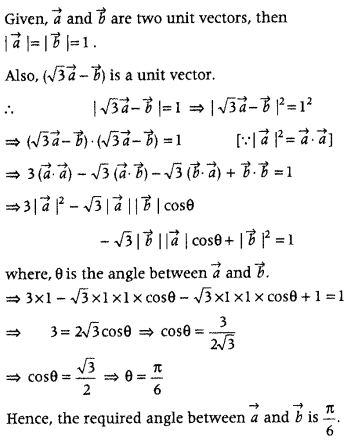
Question 20.
If |
Answer:
let θ be the angle between latex]\vec{a}[/latex] and 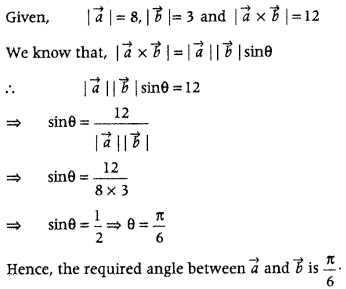
Question 21.
Write the projection of the vector
Answer:
Question 22.
Write the value of λ, so that the vectors a = 2î + λĵ + k̂ and b = î – 2ĵ + 3k̂ are perpendicular to each other. (Delhi 2013C, 2008)
Answer:
Given vectors are
and
Since, vectors are perpendicular.
∴
⇒ (2î + λĵ + k̂) ∙ (î – 2ĵ + 3k̂)
⇒ 2 – 2λ + 3 = 0
∴ λ = 5/2
Question 23.
Write the projection of (
Answer: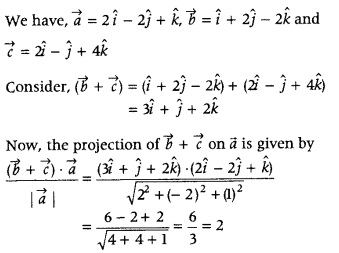
Question 24.
Write the projection of the vector 7î + ĵ – 4k̂ on the vector 2î + 6 ĵ + 3k̂. (Delhi 2013C)
Answer:
Question 25.
If
Answer: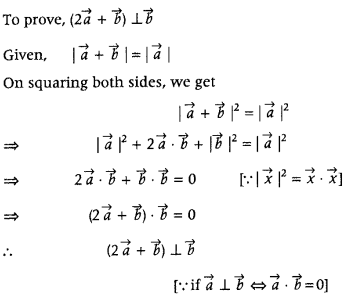
Question 26.
Find |
Answer:
Given, 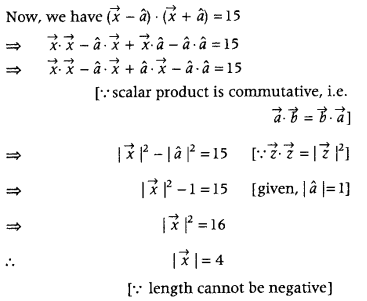
Question 27.
Find λ, when projection of
Answer:
Given, 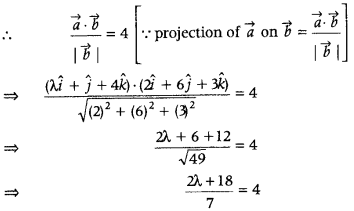
⇒ 2λ + 18 = 28
⇒ 2λ = 10
∴ λ = 5
Question 28.
Write the value of (k̂ × ĵ) . î + ĵ . k̂. (All India 2012)
Answer:
Use the results k̂ × ĵ = – î
ĵ ∙ k̂ and î ∙ î = 1 and simplify it.
Given, (k̂ × î) ∙ î + ĵ ∙ k̂ = (- î) ∙ î + ĵ ∙ k̂
= – (î ∙ î) + 0 = – 1 [∵ (î ∙ î) = 1]
Question 29.
If
Answer: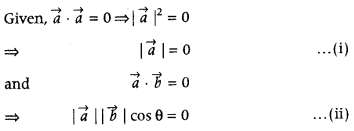
From Eqs. (i) and (ii). it may be concluded that
Question 30.
Write the projection of vector î – ĵ on the vector î + ĵ. (All India 2011)
Answer:
0
Question 31.
Write the angle between vectors
Answer:
let θ be the angle between
cos θ =

Question 32.
For what value of λ are the vectors î + 2λĵ + k̂ and 2î + ĵ – 3k̂ perpendicular? (All India 2011C)
Answer:
Question 33.
If |
Answer: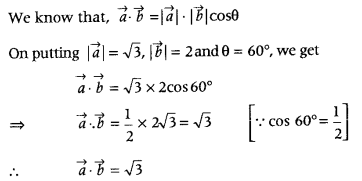
Question 34.
Find the value of λ, if the vectors 2î + λĵ + 3k and 3î + 2ĵ – 4k̂ are perpendicular to each other. (All India 2010c)
Answer:
3
Question 35.
If |
Answer: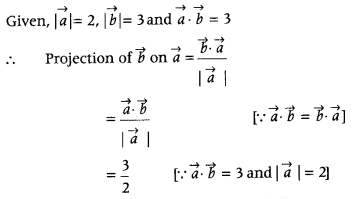
Question 36.
If
Answer:
Use the following formulae:
and
where, θ is the angle between 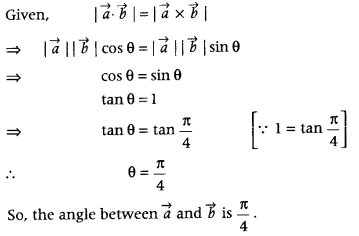
Question 37.
Find λ, if (2î + 6ĵ + 14k̂) × (î – λĵ + Ik̂) = 0. (All India 2010)
Answer:
– 3
Question 38.
If the sum of two unit vectors a and b is a unit vector, show that the magnitude of their difference is √3. (Delhi 2019, 2012c)
Answer:
let 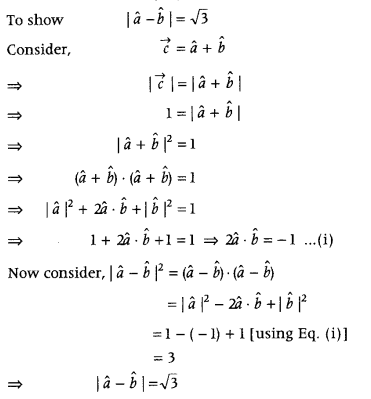
[taking positive square root, as magnitude cannot be negative]
Question 39.
If
Answer: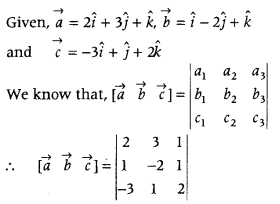
= 2(- 4 – 1) – 3(2 + 3) + 1(1 – 6)
= – 10 – 15 – 5 = – 30
Question 40.
If |
Answer:
let θ be the angle between 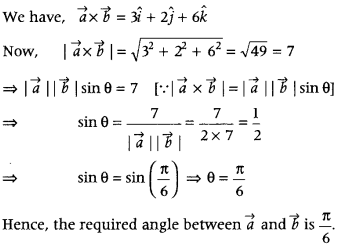
Question 41.
Find the volume of cuboid whose edges are given by -5î + 7ĵ + 5k̂, -5î + 7ĵ – 5k̂ and 7î – 5 ĵ – 5k̂. (All India 2019)
Answer: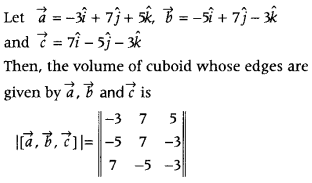
= |- 3 (- 21 – 15) – 7 (15 + 21) + 5(25 – 49)|
= |1108 – 252 – 120|
= 264 cubic units
Question 42.
Show that the points A(-2î + 5ĵ + 5k̂), B(î + 2 ĵ + 5k̂) and C(7î – k̂) are collinear. (All India 2019)
Answer: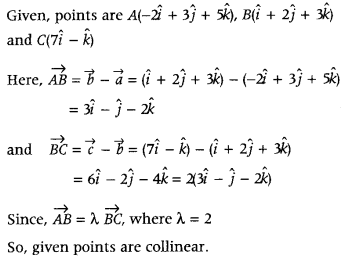
Question 43.
Find
Answer:
We have,
∴
= î ( – 2 – 15) – ĵ (- 4 – 9) + k̂(10 – 3)
= – 17î + 13ĵ + 7k̂
Question 44.
If θ is the angle between two vectors î – 2 ĵ + 3k̂ and 3î – 2 ĵ + k̂, find sin θ. (CBSE 2018)
Answer:
let 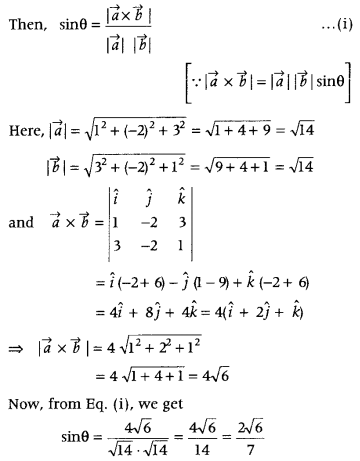
Question 45.
If
Answer: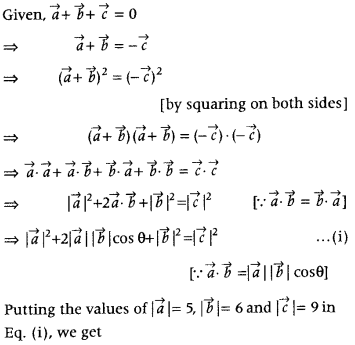
(5)2 + 2 × 5 × 6 × cos θ + (6)2 = (9)2
⇒ 25 + 60 cos θ + 36 = 81
⇒ cos θ =
⇒ θ = cos-1
Question 46.
If î + ĵ + k̂, 2î + 5ĵ, 5î + 2ĵ – 5k̂ and î – 6ĵ – k̂ respectively, are the position vectors of points A, B, C and D, then find the angle between the straight lines AB and CD. Find whether
Answer: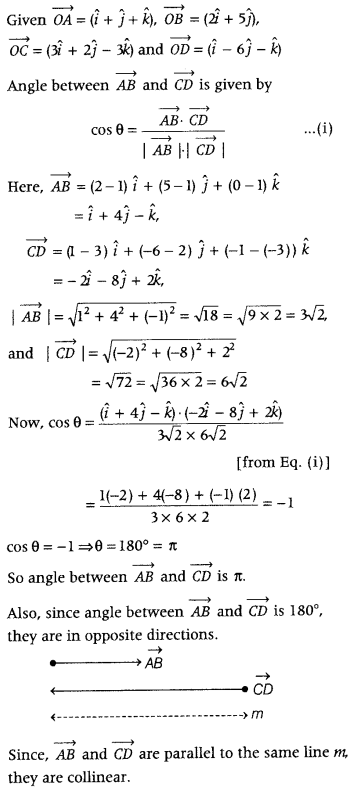
Question 47.
The scalar product of the vector
Answer: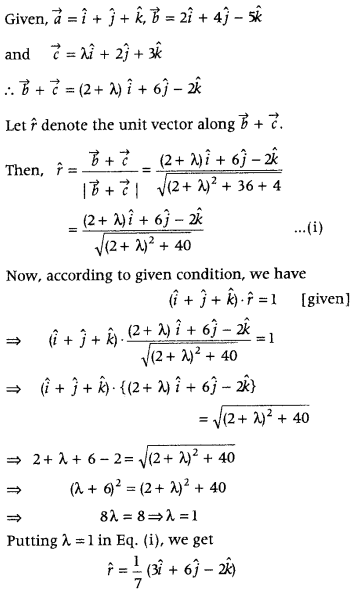
Question 48.
Let
Answer:
We have,
Since, 
= λ[î(5 – 4) – ĵ(15 + 1) + k̂(- 12 – 1)]
= λ(î – 16ĵ – 13k̂)
Also, it is given that
∴ λ(î – 16ĵ – 13k̂) ∙ (4î + 5ĵ – k̂) = 21
⇒ λ(4 – 80 + 13) = 21
⇒ λ(- 63) = 21
⇒ λ =
Now from Eq. (j), we get
Question 49.
Find x such that the four points A(4, 4, 4), B(5, x, 8), C(5, 4, 1) and D (7, 7, 2) are coplanar. (CBSE 2018C)
Answer:
Given points are A(4, 4, 4), B (5, x, 8), C(5, 4, 1) and D(7, 7, 2), then position vectors of A, B, C and D respectively, are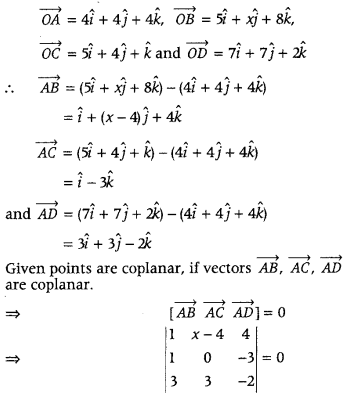
⇒ 1(0 + 9) – (x – 4) (- 2 + 9) + 4(3 – 0) = 0
⇒ 9 – (x – 4) (7) + 12 = 0
⇒ 9 – 7x + 28 + 12 = 0
⇒ 49 – 7x = 0
⇒ 7x = 49
⇒ x = 7
Question 50.
Find the value of x such that the points A(3, 2, 1), B(4, x, 5), C(4, 2,- 2) and D (6, 5, -1) are coplanar. (All India 2017)
Answer:
5
Question 51.
If
Answer:
If three vectors
cos θ = 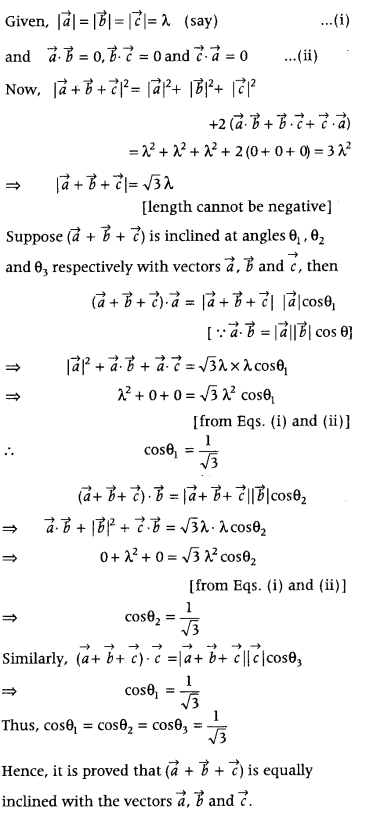
Question 52.
Using vectors, find the area of the ΔABC, whose vertices are A(1, 2, 5), 5(2, -1, 4) and C(4, 5, -1). (Delhi 2017; All India 2013)
Answer:
Let the position vectors of the verices A, B and C of ΔABC be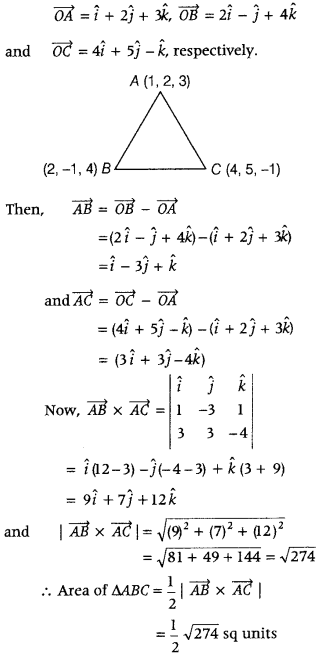
Question 53.
Let
(a) Let c1 = 1 and c2 = 2, find c3 which makes
(b) If c2 = – 1 and c3 = 1, show that no value of c1 can make
Answer:
Given,
The given vectors are coplanar iff
(a) If c1 = 1 and c2 = 2,
Then, from Eq.(i), we get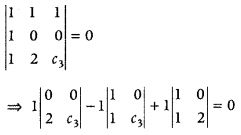
⇒ – 1(c3 – 0) + 1(2 – 0) = 0
⇒ – c3 + 2 = 0
⇒ – c3 = – 2
⇒ c3 = 2
(b) If c2 = – 1 and c3 = 1, then from Eq. (i), we get
⇒ 1(0) – 1(1 – 0) + 1(- 1 – 0) = 0
⇒ 0 – 1 – 1 = 0
⇒ – 2 ≠ 0
∴ No value of c1 can make 1’ and coplanar.
Hence proved
Question 54.
Show that the points A, B, C with position vectors 2î – ĵ + k̂, î – 5ĵ – 5k̂ and 5î – 4ĵ – 4k̂ respectively, are the vertices of a right-angled triangle. Hence find the area of the triangle. (All India 2017)
Answer:
Question 55.
Show that the vectors
Or
Prove that, for any three vectors
Answer: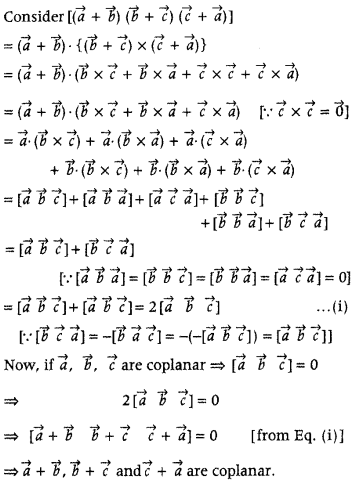
Question 56.
Show that the four points A (4, 5, 1), B(0, -1, -1), C(3, 9, 4) and D (-4, 4, 4) are coplanar. (All India 2016)
Or
Show that the four points A, B, C and D with position vectors 4î + 5ĵ + k̂, – ĵ – k̂, 3î + 9ĵ + 4k̂ and 4(- î + ĵ + k̂), respectively are coplanar. (All India 2014)
Answer:
Let the position vector of points A, B, C and D are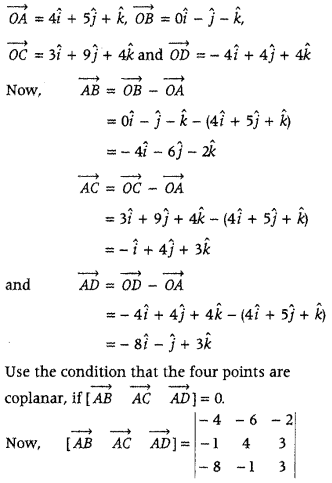
= – 4(12 + 3) + 6 (- 3 + 24) – 2(1 + 32)
= – 60 + 126 – 66 = 0
Hence, the four points A, B, C and D are coplanar.
Question 57.
The two adjacent sides of a parallelogram are 2î – 4ĵ – 5k̂ and 2î + 2 ĵ + 3k̂. Find the two unit vectors parallel to its diagonals. Using the diagonal vectors, find the area of the parallelogram. (All India 2016)
Answer:
Let ABCD be the given parallelogram with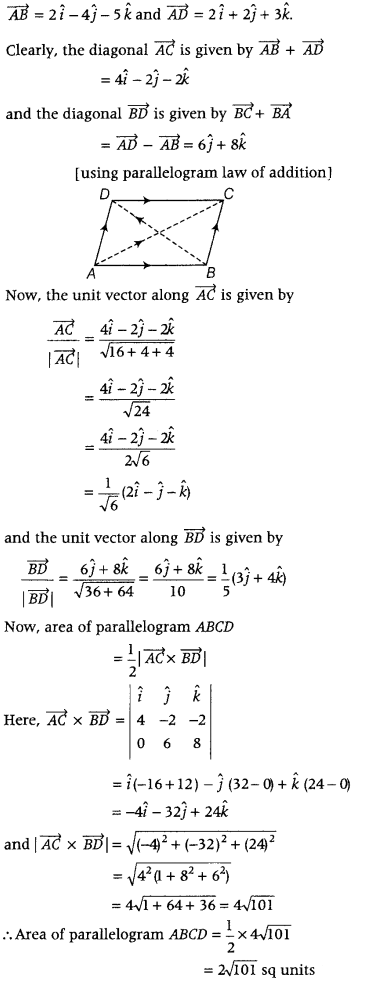
Question 58.
If
Answer:
Use the result, if two vectors are parallel, then their cross-product will be a zero vector.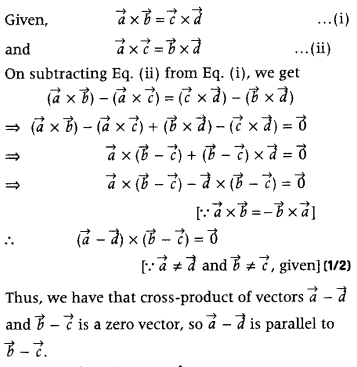
Question 59.
If
Answer:
Question 60.
If
Answer: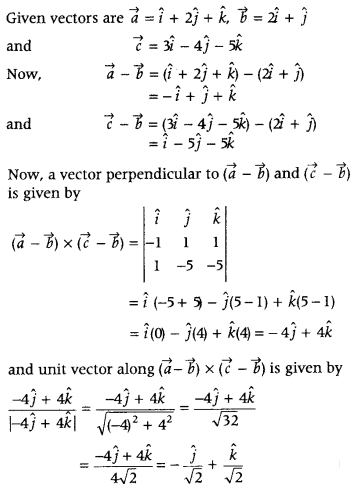
Question 61.
Find the value of λ so that the four points A, B,C and D with position vectors 4 î + 5ĵ + k̂, -ĵ – k̂,3i + Xj+4k and – 4 î + 4ĵ + 4 k̂, respectively are coplanar. (Delhi 2015C)
Answer:
Use the condition that four points with position vectors 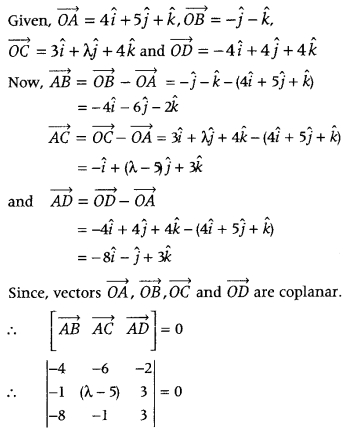
On expanding along R1, we get
⇒ – 4(3λ – 15 + 3) + 6(- 3 + 24) – 2(1 + 8λ – 40) = 0
⇒ – 4(3λ – 12) + 6(21) – 2(8λ – 39) = 0
⇒ – 12λ + 48 + 126 – 16λ + 78 = 0
⇒ – 28λ + 252 = 0
λ = 9
Question 62.
Prove that
Answer: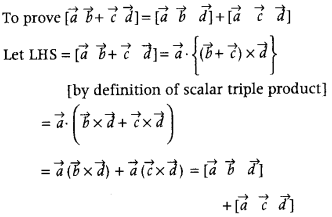
Question 63.
If
Answer: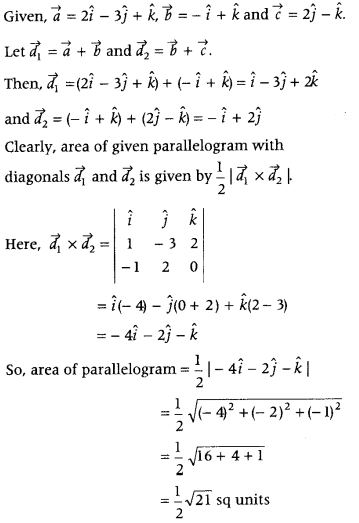
Question 64.
Vectors
Answer:
Question 65.
The scalar product of the vector
Or
The scalar product of vector i + j + k with the unit vector along the sum of vectors 2î + 4ĵ – 5k̂ and λî + 2ĵ + 3k̂ is equal to one. Find the value of λ. (All India 2009,2008C)
Answer:
First, determine the unit vector of 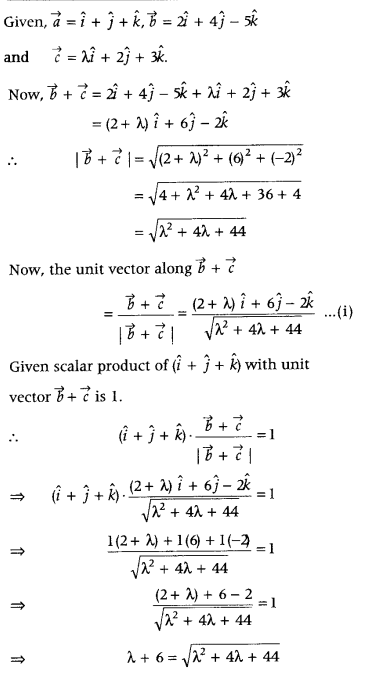
⇒ (λ + 6)2 = λ2 + 4λ + 44 [squaring both sides]
⇒ λ2 + 36 + 12λ + 4λ + 44
⇒ 8λ = 8
⇒ λ = 1
Hence, the value of λ is 1.
On substituting the value of λ in Eq. (1), we get Unit vector along 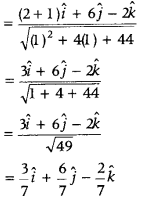
Question 66.
Find the vector
Answer: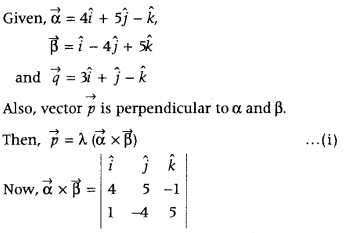
= î (25 – 4) – ĵ (20 + 1) + k̂(- 16 – 5)
= î(21) – ĵ(21) + k̂(- 21)
= 21î – 21ĵ – 21k̂
So,
Also, given that
∴ (21λî – 21λĵ – 21λk̂) . (3î + ĵ – k̂) = 21
⇒ 63λ – 21λ + 21λ = 21
⇒ 63λ = 21
⇒ λ =
On putting λ = 
which is the required vector.
Question 67.
Find the unit vector perpendicular to both of the vectors
Answer:
⇒ 2x + 3y + 4z = 0 …… (ii)
and (xî + yĵ + zk̂) . (- ĵ – 2k̂) = 0
⇒ – y – 2z = 0
⇒ y = – 2z
On putting the value of yin Eq. (ii), we get
2x + 3 (- 2z) + 4z = 0
⇒ x = z
On substituting the value of x and y in Eq. (1),
we get
⇒ z2 + 4z2 + z2 = 1
⇒ 6z2 = 1
⇒ z = ±
then, x = ±
and y = ±
Hence, the required vectors are
Question 68.
Find the unit vector perpendicular to the plane ABC where the position vectors of A, B and C are 2î – ĵ + k̂, î + ĵ + 2k̂ and 2î + 3k̂, respectively. (All India 2014C)
Answer:
A unit vector perpendicular to plane ABC is
Let O be the origin of reference.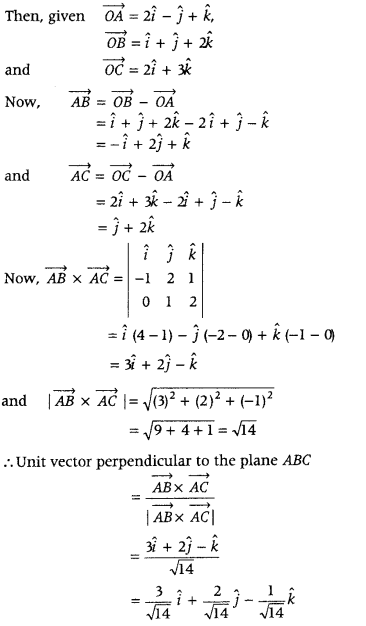
Question 69.
Dot product of a vector with vectors î – ĵ + k̂, 2î + ĵ – 3k̂ and î + ĵ + k̂ are respectively 4, 0 and 2. Find the vector. (Delhi 2013C)
Answer:
⇒ a1 + a2 + a3 = 2
On subtracting Eq. (iii) from Eq. (i), we get
– 2a2 = 2
⇒ a2 = – 1
On substituting a2 = – 1 in Eq. (ii) and (iii),
we get
2a2 – 3a3 = 1 …… (iv)
⇒ a1 + a3 = 3
On multiplying Eq. (v) by 3 and then adding with Eq. (iv), we get
5a1 = 1 + 9 = 10
⇒ a1 = 2
On substituting a1 = 2 in Eq. (v), we get
a3 = 1
Hence, the vector is
Question 70.
Find the values of λ for which the angle between the vectors
Answer:
let θ be the obtuse angle between the vectors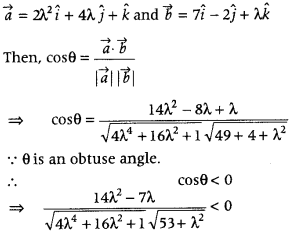
14λ2 – 7λ < 0
= 2λ2 – λ < 0
Either λ < 0, 2λ – 1 > 0 or λ > 0, 2λ – 1 < 0
= Either λ < 0, λ >
0 < λ <
λ ∈
Question 71.
If a, b and c are three vectors such that each one is perpendicular to the vector obtained by sum of the other two and |
Or
If
Answer: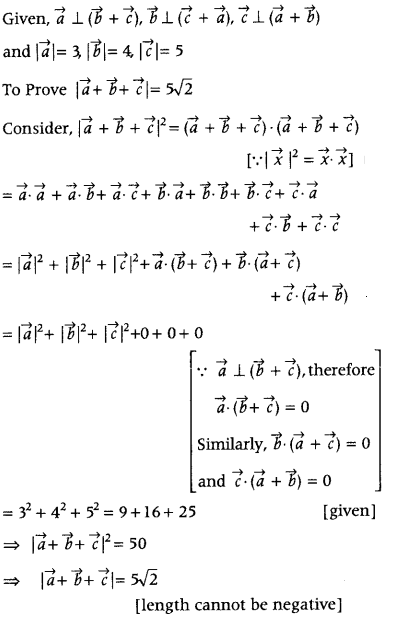
Question 72.
If
Answer:
Given
Let
Consider,
⇒ (x1 + x2)î + (y1 + y2)ĵ + (z1 + z2)k̂ = 2î + ĵ – 3k̂
On comparing the coefficient of î ĵ and k̂ both sides, we get
x1 + x2 = 2
y1 + y2 = 1
z1 + z2 = -3
Now, consider
⇒
⇒ x1 = 3λ, y1 = -λ,and z1 = 0 …(iv)
On substituting the values of x, y and z, from Eq. (iv) to Eq. (i), (ii) and (iii), respectively, we get
x2 = 2- 3λ, y2 = -1 + λ and z2 = -3 …(v)
Since, b2 ± a , therefore b2 a = 0
⇒ 3x2 – y2 = 0
⇒ 3 (2 – 3λ) – (1 + λ) = 0
⇒ 6 – 9λ – 1 – λ = 0
⇒ 5 – 10λ = 0
⇒ λ =
On substituting λ = 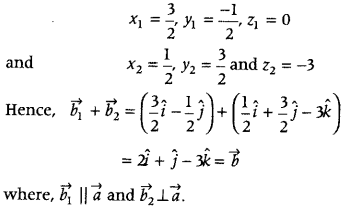
Question 73.
If
Answer:
Given
Let 
= î (z – y) – ĵ(z – x) + k̂(y – x)
Now,
= î(z – y) + ĵ(x – z) + k̂(y – x)
= 0î + 1ĵ + (-1)k̂ [∵
On comparing the coefficients from both sides, we get
z – y = 0,x – z = 1, y – x = -1
⇒ y = z and x – y = 1…(i)
Also given,
⇒ (î + ĵ + k̂) . (xî + yĵ + zk̂) = 3
⇒ x + y + z = 3 (1)
⇒ x + 2y = 3 [∵ y = z] …(ii)
On subtracting Eq. (i) from Eq. (ii), we get
3y = 2
⇒ y =
From Eq. (i),
x = 1 + y + 1 = 1 +
Hence,
Question 74.
If
Answer:
Use the result that if
Given,
Then,
= 6î – 2ĵ + (7 + λ) k̂
and a – = (î – ĵ + 7k̂) – (5î – j ̂+ λk̂)
= -4î + (7 – λ)k̂
Since,
vectors, then
⇒ [6î – 2ĵ + (7 + λ)k̂]- [-4î + (7 – λ)k̂] = 0 (1)
⇒ -24 + (7+ X)(7 – X) =0
⇒ 49 – λ2 = 24
⇒ λ2 = 25
∴ λ = ± 5
Question 75.
If p = 5î + λĵ – 3k̂ and q = î + 3ĵ – 5k̂, then find the value of λ, so that
Answer:
λ = ± 1
Question 76.
If
Answer:
-169
Question 77.
Let
Answer:
Given vectors are
and
Let
We have,
⇒ (xî + yĵ + zk̂) – (î + 4ĵ + 7k̂) = 0
⇒ x + 4y + 2z = 0 ………….(i)
and
⇒ (xî + yĵ + zk̂) . (3î – 2ĵ + 7k̂) = 0
⇒ 3x – 2y + 7z = 0 …(ii)
Also, given ~p-~c =18 (1)
⇒ (xî + yĵ + zk̂) . (2î – ĵ + 4k̂) = 0
⇒ 2x – y + 4z = 18 …(iii)
On multiplying Eq. (i) by 3 and subtracting it from Eq. (ii), we get
– 14y + z = 0 ..(iv)
Now, multiplying Eq. (i) by 2 and subtracting it from Eq. (iii), we get
– 9y = 18
⇒ y = -2
On putting y = -2 in Eq. (iv), we get
-14 (-2) + z = 0
⇒ 28 + z = 0
⇒ z = -28
On putting y = -2 and z = -28 in Eq. (i), we get
x + 4 (-2) + 2 (-28) = 0
⇒ x – 8 – 56 = 0
⇒ x = 64
Hence, the required vector is
i.e.
Question 78.
Find a unit vector perpendicular to each of the vectors
Answer:
Question 79.
If a and 6 are two vectors, such that |
Answer: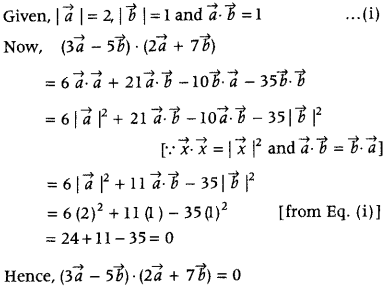
Question 80.
If vectors
Answer:
Given,
and
Also,
∴ (
Now,
⇒
Then, from Bq. (i), we get
[î (2 – λ) + ĵ (2 + 2λ) + k̂(3 + λ)].[3î + ĵ] = 0
⇒ 3(2 – λ) + 1(2+ 2k) = 0
⇒ 8 – λ = 0
∴ λ = 8
Question 81.
Using vectors, find the area of triangle with vertices A (1, 1, 2), 5(2, 3, 5) and C (1, 5, 5). (All India 2011)
Answer:
Question 82.
Using vectors, find the area of triangle with vertices A (2, 3, 5), B (3, 5, 8) and C(2, 7, 8). (Delhi 2010C)
Answer:
Some Extra Question
Q. No. 2: Find the unit vector in the direction of the sum of the vectors
Solution:

The unit vector is:

Q. No. 3: Find the vector joining the points P(2, 3, 0) and Q(– 1, – 2, – 4) directed from P to Q.
Solution:
Since the vector is to be directed from P to Q, clearly P is the initial point and Q is the terminal point.
P(2, 3, 0) = (x1, y1, z1)
Q(-1, -2, -4) = (x2, y2, z2)
Vector joining the points P and Q is:

Solution:


Solution:

Then,
cos α = 1/√3, cos β = 1/√3 cos γ = 1/√3
Hence, the given vector is equally inclined to axes OX, OY and OZ.
Q. No. 6: Show that the points A, B and C with position vectors
form the vertices of a right-angled triangle.
Solution:
Position vectors of points A, B and C are respectively given as below.

Therefore, ABC is a right-angled triangle.
Solution:
From the given,
m = cos π/4 = 1/√2
n = cos π/2 = 0
Therefore, l2 + m2 + n2 = 1
l2 + (½) + 0 = 1
l2 = 1 – ½
l = ±1/√2
Hence, the required vector is:

Q. No. 8: Evaluate the product.
Solution:

Q. No. 9: Find all vectors of magnitude 10√3 that are perpendicular to the plane of
Solution:



Q. No. 10: Find the area of the triangle with vertices A(1, 1, 2), B(2, 3, 5) and C(1, 5, 5).
Solution:
Vertices of a triangle ABC are A(1, 1, 2), B(2, 3, 5) and C(1, 5, 5).
Let AB and BC be the adjacent sides of triangle ABC.

Hence, the area of triangle ABC is √61/2 sq.units
Practice Questions For Class 12 Maths Chapter 10 Vector Algebra
- Using vectors find the area of triangle PQR, whose vertices are P(1, 2, 3), Q(2, -1, 4) and C(4, 5, -1).
- Use vector method to show that P,Q,R are Collinear – P(3, -5, 1), Q(-1, 0, 8) and C(7, -10, -6)
- Find the angles between the lines whose direction ratios are 3, 2, -6 and 1, 2, 2. Find the angles of a triangle PQR whose vertices are P(-1, 3, 2), B(2, 3, 5) and C(3, 5, -2).
- Prove that the points P(-2, 4, 7), Q (3, -6, -8) and R(1,-2,-2) are collinear.
- Find the angle between the lines whose direction ratios are: 2, -3, 4 and 1, 2, 1.
- Using vectors, find the value of k such that the points (k, – 10, 3), (1, –1, 3) and (3, 5, 3) are collinear.
- Using vectors, prove that the parallelogram on the same base and between the same parallels are equal in area.
- Show that:

- Show that each of the given three vectors is a unit vector:
